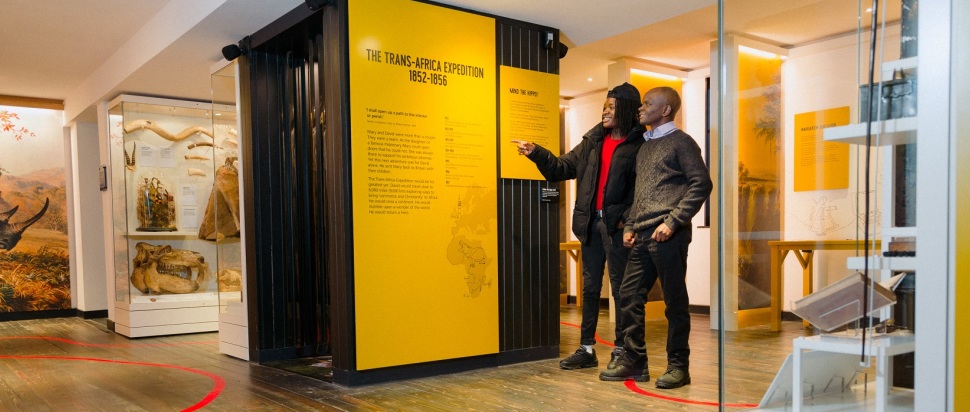Who was Dr David Livingstone, and why should we care?
David Livingstone's life was full of contradictions. He was a man of science and God. He was an abolitionist and key to the colonisation of Africa. He was celebrated as a lone pioneer but travelled with many companions. We unpick these paradoxes

“When the legend becomes fact,” so the old adage goes, “print the legend.” That’s largely what happened to the Scottish explorer, geographer, medical missionary and abolitionist Dr David Livingstone. His epic and often treacherous expeditions across sub-Saharan Africa in the mid-19th century made him hugely famous in his own time and a larger than life hero of many a Victorian boy’s own adventure book.
His achievements became legendary. The stories go he “discovered” the Victoria Falls – although more accurately, he became the first white European to see the majestic Mosi-oa-Tunya situated on Zimbabwe’s border with Zambia, which he renamed in honour of the Queen. He’s also famous for being discovered himself, by Welsh-American explorer and journalist Henry Morton Stanley who’d been sent to find the Scot when he’d gone off-grid in Africa, greeting him with the famous line "Dr Livingstone, I presume?" He’s also remembered for battling a lion, clashes with the Boer, and his death while searching for the source of the Nile. Among all this adventure and derring-do, he also tried to end the East African Slave Trade.
Like all legends, there are grains of truth to be found in the potted history above but much has been elided. Thankfully it’s become easier to unpick and examine the various conflicting elements of Livingstone’s legacy thanks to the reopening last summer of the David Livingstone Birthplace in Blantyre. Located in the tenement where Livingstone lived as a boy and worked at a neighbouring mill, this redeveloped museum aims to break the various myths about Livingstone and dig into the many sides of the explorer that are still little-known or misunderstood.
For Natalie Milor, the museum's curator, one of the chief preconceptions about Livingstone that she’s keen to quash is the romantic notion of him as a solitary pioneer. “I think the narrative around Livingstone, and all the statues and art that was made about him, particularly just after he died, in the period of the late 19th and early 20th century, was really representing him as a lone explorer.”
Going back to Livingstone’s diaries and expedition papers, it becomes clear that Livingstone had many companions on his adventures, both white Europeans and Africans he recruited on his travels. At times, he essentially led a small village across the continent. “There's an awful lot of evidence we can look through to learn more about his relationship with his crew members and about crew members themselves,” says Milor. “It has been convenient for specific people with specific political ideologies to see Livingstone through this lone explorer lens and as a lone spreader of Christianity in Southern and Central Africa. A lot of our exhibition is about looking at who's missing from these narratives and showing that the story is much more interesting and relevant with everybody being represented as far as we can.”
The exhibition goes to great lengths to give Livingstone's crew members their due, but particularly the vital roles played by two figures whose huge contributions to Livingstone’s story have been diminished, those of Abdullah Susi and James Chuma.
The pair, who hailed from Central Africa, began working with the doctor during his troubled Zambezi Expedition, which ran from 1858 to 1864. They were then recruited again to join him as part of the Nile expedition. “In prevailing narratives, Susi and Chuma were always seen as ‘faithful companions’ and they weren't really given the kind of recognition that they deserved as really pivotal members of his crew,” says Milor. "Particularly during the Nile Expedition, where Livingstone was heavily dependent on them, not just helping with the expedition but literally physically taking care of him at some points when he got really ill.”

Their significance is certainly explored across the exhibition at David Livingstone Birthplace Museum, particularly in the Tales of the Tableaux, a series of animations created using a screenplay by Petina Gappah, that complement the newly restored Pilkington Jackson Tableaux, eight sculptures created by Charles d’Orville Pilkington Jackson in the late 1920s that helped perpetuate the romantic myth of Livingstone as a lone heroic figure in Africa. Tales from the Tableaux bring Pilkington Jackson’s tableaux to life, expanding his story to include the various Southern and Central African people who helped make his expeditions possible. “Tales from the Tableaux make clear Susi and Chuma were missionaries and explorers in their own right,” explains Milor. “They're not widely recognised figures. Given their contribution to Livingstone's achievements, it is a travesty they're not better known.”
Livingstone himself has become less well-known in recent decades, in part thanks to the complexities of his legacy. “Livingstone is seen as a very controversial figure in some respects,” says Milor, “and challenging for teachers to teach, which kind of explains why he's fallen out of the curriculum essentially, even for local children.” With the best intentions, Livingstone tried to open up sub-Saharan Africa for trading, working with local communities, and his pioneering work undoubtedly did contribute to the abolishment of the East African Slave Trade. But his findings in Africa were put to more sinister use after his death, with his records used by the various European powers in the 'Scramble for Africa' that saw huge parts of the continent colonised and its resources plundered. “As soon as you scratch the surface of Livingstone’s life, you do start to see these contradictions,” notes Milor.
The Livingstone Birthplace Museum doesn’t sugarcoat these contradictions. The exhibition opens by exploring Livingstone's humble beginnings working as a child labourer at Blantyre Works Mill, where he worked from the age of ten. Elsewhere, the exhibition explores the conflict he felt as a young man between his religious upbringing and his ambition to be a man of science.
“Livingstone did have a crisis of faith moment before he became part of the independent church movement,” says Milor. “Livingstone really wanted to be a doctor but his father, Neil, wanted him to have some sort of career that was related to his religious upbringing.” It was reading Thomas Dick’s Philosophy of a Future State, a book which essentially argued that science and religion could be married together, that helped Livingstone connect these two sides of himself. “It was reading Dick's book, as well as going to visit him in Broughty Ferry, that helped Livingstone put his mind at rest in terms of what he wanted to do,” explains Milor, “combined with the rise of missionary societies, which meant becoming a medical missionary was a legitimate career option.”
This epiphany not only changed Livingstone’s career path but arguably changed the world, with history telling us that this one missionary from Blantyre was responsible for the spread of Christianity in Central and Southern Africa. But like much of the history written about Livingstone, this is only a small part of a story. “We show that Livingstone actually only baptised two people," says Milor, "one of whom was Chief Sechele I of the BaKwena, whose commitment to the faith led to Christianity being widely adopted in places like Botswana. That's something that’s still not widely known, and if you look at the origins for why it's not widely known, it is inherently linked back to racism and historians' biases in terms of who they thought deserved credit for what stories.”
Livingstone’s life undoubtedly caused a ripple effect across the world, and that legacy can still be seen today. It’s a story ripe for reappraisal, and one that can be used to examine all sorts of contemporary issues, from racism to climate change. The Livingstone Birthplace Museum attempts to put this story straight by cutting through the Victorian tall tales so that his life can be properly discussed and reflected upon. “Throughout the exhibition we outlined the good, the bad and the ugly of Livingstone’s legacy," says Milor. "Ultimately we show he was human and full of flaws, but ultimately a man who made a difference in the world. I think that is more interesting than seeing him as an icon, really. Our job is to make sure people know and understand that there is a fuller picture, and they can make up their own mind as to whether or not they think Livingstone deserves to be on his pedestal still.”
David Livingstone Birthplace is open seven days a week, 10am-4pm
Tickets are available at david-livingstone-birthplace.org
